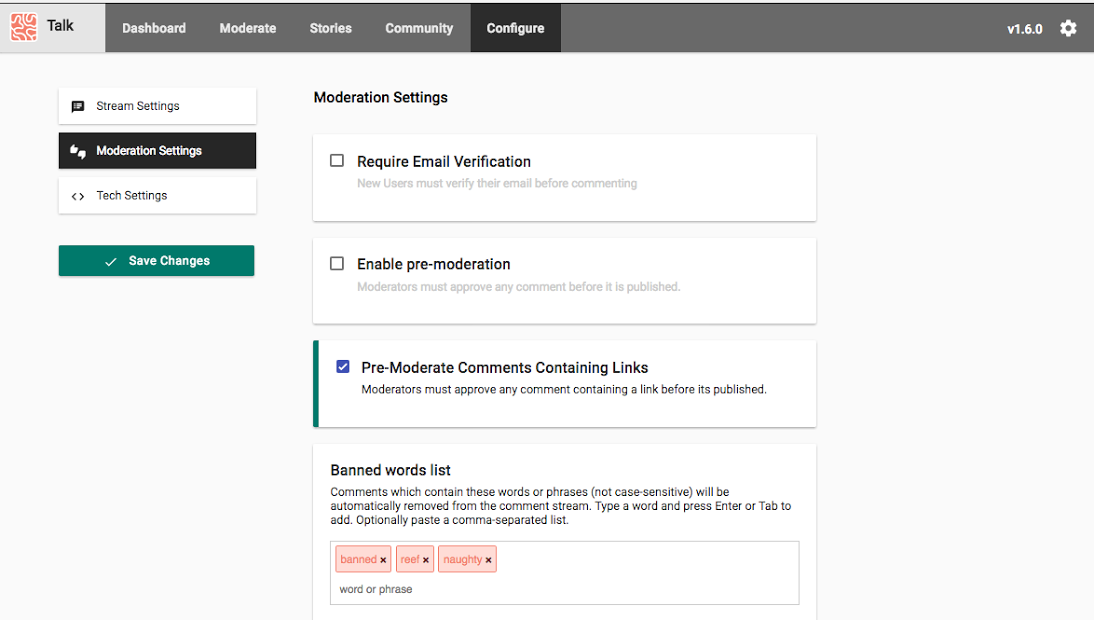
It was late April and the staff of the Coral Project was “on tenterhooks” as The Washington Post was conducting its first public test of Talk, the project’s new commenting platform, Andrew Losowsky recalled recently.
The Washington Post — which launched the Coral Project along with The New York Times, Mozilla, and the Knight Foundation to improve communities around journalism — invited about 30 commenters who were active on its Capital Weather Gang blog to try out the platform and offer feedback. The callout attracted more than 130 comments, which included Post staffers probing commenters for more details and specifics, and additional reactions submitted through a form and email.
“We were expecting people to be quite negative,” said Losowsky, the project lead. “Initial change isn’t something that people tend to welcome. It looks a bit different, it has a few different features, and the responses we got were actually very good and very respectful and thoughtful. That’s, of course, what can happen when you openly make clear that you are listening to and engaging with your readership.”
The Post plans to make the Talk platform its primary on-site commenting system, and it’s now working to further integrate it into its site with plans “to launch as soon as is practical,” said Greg Barber, the Post’s director of digital news projects.
The Coral Project, meanwhile, is taking that feedback from the Post’s users and integrating some of the changes they suggested into the platform.
Talk will replace the Post’s current commenting platform, which it calls Reverb, internally, Barber said. “It was born of necessity because our commenting vendor went out of business and we needed a solution, so we made one,” he said. “It was created during a time after the Coral Project had been announced but the Coral software wasn’t yet ready, so we needed an interim solution…it was never intended to be a permanent solution to our commenting needs. Coral was.”
The Coral Project launched in 2014 with a three-year, $3.89 million grant from the Knight Foundation that was set to expire this summer. The project has been able to secure additional funding from Mozilla and the Rita Allen Foundation to continue its work, Losowsky said, adding that they’re in conversations with additional funders, including Knight. (Disclosure: Knight also supports Nieman Lab.)Along with Talk, Coral has also released Ask, a platform that enables newsrooms to ask specific questions of their audience, and it’s planning to release guides to journalism and engagement later this year.
While the Post will be the first news organization to use the Talk system, the Coral Project is in talks with a number of other outlets who didn’t want to be among the earliest adopters, Losowsky said.
Talk was designed with the idea in mind that a commenting platform should be more than just an empty box at the bottom of a story. As journalism business models become increasingly reliant on direct reader revenue — digital subscriptions are all the rage right now — Losowsky said commenting systems should work to proactively engage readers and build community around the news:
Almost everybody online knows how to post something on Facebook or Twitter. The barriers to entry to being able to publish your thoughts online is [low]. As a result of that, news organizations need to think about what is the kind of dialogue they want to host versus the kind of dialogue that will appear elsewhere. I think it’s perfectly fine to say that there are rules here that are different from rules in other spaces, and if you want to do some other form of interaction, you can go and do it over there — but this is the kind of thing we’re looking for here. These are the baseline assumptions that we have here. Here are the things we’re trying to do with it. This is what this space is for versus that space.
Being able to really define that, I think, is going to be really important. On the one hand, news organizations are not going to win in a battle with Facebook to create the best social network. But what news organizations can do is create a space which gives direct access to the journalists, that has the ability to bring the community into the process and be part of the process, manage interaction on the news organizations’ terms rather than Facebook’s terms about what is visible, what moderation tools you have, about the ability to focus and highlight on different conversations and so on. And news organizations can be transparent about how they’re using people’s data and really safeguard the privacy and transparency around the data of every interaction that they’re having with the community.
On every article, news orgs using Talk can set an opening prompt at the top of the box to try guide the discussion and keep the conversation on-topic. Other features meant to facilitate productive discussions include the ability to add context to reports of inappropriate comments, banned words that are automatically rejected and suspect words that are flagged for moderation, and badges for staff members so they’re easily identifiable.

Moderators are able to ban users directly from the comment, and the moderation dashboard automatically highlights banned and suspect words. They can also pin their favorite comments at the top of the feed, to highlight the best comments and also set the tone for the conversation.


“There are a lot of things that we’re focusing on — first of all, from the commenter’s perspective, really thinking about how do we indicate what’s wanted in the space and use subtle cues to encourage and improve the behavior,” Losowsky said. “Then, from the moderator or journalist’s side, how do we create tools to make it fast and easy to be able to do the actions that they need to take — remove the bad content, ban users who are abusing the system, suspend those who in some way are perhaps redeemable or having a bad day and give them a time out, and then be able to not only approve but highlight really good comments so that you’re indicating the kind of behavior you want to encourage.”
Talk, like everything The Coral Project has produced, is open source, so outlets can build upon it as they like and the entire Talk system is built around plugins, with the idea that publishers can tailor the system to their needs. The Coral Project also offers hosting services, which could be useful for smaller newsrooms.
For its part, the Post has been conducting quality assurance testing and also making sure the code in Talk doesn’t interfere with any of the other Post’s services. It was also tested on the Post’s development and staging servers to make sure everything worked properly before it was rolled out to users.
Barber said the test in late April was unusual because the Post conducted it before it was able to hook Talk up to its own authentication system, which is one of the ways that it’s customizing the platform to hook up to its infrastructure. The Post is also connecting Talk to the systems it uses to monitor its servers and hooking it into its CMS so comment streams can automatically be created for stories.
“The Coral Project group is continuing to build core features onto Talk and to take some of its features and turn those into plugins that are more accessible to organizations like the Post, so that we can tinker with them, as we’re often wont to do, to customize in different ways,” Barber said. “Other organizations that are interested in customizing in the same way that we are — or in ways that are different from what we want to do — will have that capability as well. The Coral team, of course, is critical to this. They’re building the main software, they’re building the main functionality, they’re giving us the spaces to customize the bits and pieces we want to work in specific ways. But then what The Washington Post team is doing is working on specific plugins that might not fit Coral’s overall strategy, but are things that we want to do here.”
The Coral Project team is also working on adding new features based on the feedback it received from Post commenters who tested out Talk last month. The current Post commenting system, for instance, allows readers to edit comments. Talk didn’t. They’re now working on adding an edit feature to Talk. Outlets will be able to set a time limit for — maybe five or 10 seconds — for commenters to read over their post and edit it before it goes live.
“If you change your mind, if you regret it, if you see a typo you still have a window in which you can edit and change it,” Losowsky said. “That was something that was requested by a number of different Washington Post people.”
Barber and Teddy Amenabar, the Post’s comments editor, were active in the comments for the test last month, thanking users for feedback and asking questions such as “Anything missing that you’d like to see in a new system?” They collected that feedback and created a spreadsheet with the information that they then shared with the Coral Project. The Coral Project plans to take that feedback and continue to build out Talk while also looking for ways to help news organizations develop their engagement strategies and define what kind of conversations they want to host on their own platforms.
“What do you want from us in this space from the perspective of the audience? And from the perspective of the journalist, what do we want in this space? What do we want to happen here? By outlining and making clear what your expectations are for the space, you’re already creating a greater likelihood of success.”